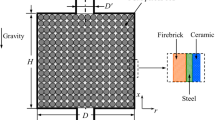Abstract
This paper discusses the results of numerical and experimental study of an encapsulated cool thermal energy storage system. The storage system is a cylindrical storage tank filled with phase change material encapsulated in spherical container, placed in a refrigeration loop. A simulation program was developed to evaluate the temperature histories of the heat transfer fluid and the phase change material at any axial location during the charging period. The present analysis aims at studying the influence of the inlet heat transfer fluid temperature and porosity on system performance. An experimental setup was designed and constructed to conduct the experiments. The results of the model were validated by comparison with experimental results of temperature profiles for different inlet heat transfer fluid temperatures and porosity. The results are in good agreement with the experimental results. The results reported are much useful for designing cool thermal energy storage systems.











Similar content being viewed by others
Abbreviations
- A s :
-
wetted capsule area per storage volume, m−1
- A c :
-
area of cross section of cylinder, m3
- A sp :
-
area of cross section of spherical capsule, m2
- c :
-
specific heat, J kg−1 K−1
- h :
-
internal heat transfer coefficient, W m−2 K−1
- k :
-
thermal conductivity, W m−1 K−1
- L :
-
height of storage tank, m
- m :
-
mass flow rate, kg s−1
- Pe :
-
Peclet number
- Q :
-
energy stored, J
- Q x :
-
dimensionless instantaneous energy stored
- St :
-
Stanton number
- Ste :
-
Stefan number
- t :
-
dimensional time, s
- T:
-
temperature, K
- u:
-
velocity, m s−1
- V :
-
total volume of storage tank, m3
- V sp :
-
volume of spherical capsule, m3
- x :
-
axial coordinate, m
- x + :
-
non-dimensional axial location
- α:
-
thermal diffusivity
- ε:
-
porosity
- θ:
-
dimensionless temperature
- ρ:
-
density, kg m−3
- τ:
-
dimensionless time
- λ:
-
latent heat of solidification, J kg−1
- β:
-
solidified mass fraction
- f:
-
heat transfer fluid
- fi:
-
heat transfer fluid at inlet
- fo:
-
heat transfer fluid at outlet
- l:
-
liquid state
- p:
-
phase change material
- pi:
-
phase change material at initial condition
- ps:
-
phase change material in solid state
- s:
-
solidification (or melting) state
- CTES:
-
Cool thermal energy storage
- CV:
-
Control volume
- HTF:
-
Heat transfer fluid
- PCM:
-
Phase change material
References
Hasnain SM (1998) Review on sustainable thermal energy storage technologies. Part II: cool thermal storage technologies. Energy Convers Manage 39:1139–1152
Saito A (2002) Recent advances in research on cold thermal energy storage. Int J Refrig 25:177–189
Zalba B, Marin JM, Cabeza LF, Mehling H (2003) Review on thermal energy storage with phase change: materials, heat transfer analysis and applications. Appl Therm Eng 23:251–283
Arnold D (1990) Dynamic simulation of encapsulated ice stores. Part I: the model. ASHRAE Trans 96(1):1103–1110
Arnold D, Eng C (1991) Laboratory performance of an encapsulated ice store. ASHRAE Trans 97(2):1245–1254
Chen SL, Yue JS (1991) A simplified analysis for cold storage in porous capsules with solidification. ASME J Energy Resour Technol 113:108–116
Chen SL, Yue JS (1991) Thermal performance of cool storage in packed capsules for air conditioning. Heat Recov Syst CHP 11(6):551–561
Chen SL, Chen CL, Tin CC, Lee TS, Ke MC (2000) An experimental investigation of cold storage in an encapsulated thermal storage tank. Exp Therm Fluid Sci 23:133–144
Bedecarrats JP, Strub F, Falcon B, Dumas JP (1996) Phase-change thermal energy storage using spherical capsules: performance of a test plant. Int J Refrig 19(3):187–196
Velraj R, Seeniraj RV, Hafner B, Faber C, Schwarzer K (1999) Heat transfer enhancement in a latent heat storage system. Solar Energy 65:171–180
Velraj R, Seeniraj RV (1999) Heat transfer and parametric studies of an internally finned LHTS via an enthalpy model. Trans ASME J Heat Transfer 121:493–497
Keumnam Cho, Choi SH (2000) Thermal characteristics of paraffin in a spherical capsule during freezing and melting processes. Int J Heat Mass Transfer (43):3183–3196
Bo He, Fredrik Setterwall (2002) Technical grade paraffin waxes as phase change materials for cool thermal storage and cool storage systems capital cost estimation. Energy Convers Manage 43:1709–1723
Adref KT, Eames IW (2002) Experiments on charging and discharging of spherical thermal (ice) storage elements. Int J Energy Rese 26:949–964
Eames IW, Adref KT (2002) Freezing and melting of water in spherical enclosures of the type used in thermal (ice) storage systems. Appl Therm Eng 22:733–745
Kousksou T, Bedecarrats JP, Dumas JP, Mimet A (2005) Dynamic modeling of the storage of an encapsulated ice tank. Appl Therm Eng 25:1534–1548
Author information
Authors and Affiliations
Corresponding author
Rights and permissions
About this article
Cite this article
Cheralathan, M., Velraj, R. & Renganarayanan, S. Effect of porosity and the inlet heat transfer fluid temperature variation on the performance of cool thermal energy storage system. Heat Mass Transfer 43, 833–842 (2007). https://doi.org/10.1007/s00231-006-0163-1
Received:
Accepted:
Published:
Issue Date:
DOI: https://doi.org/10.1007/s00231-006-0163-1




